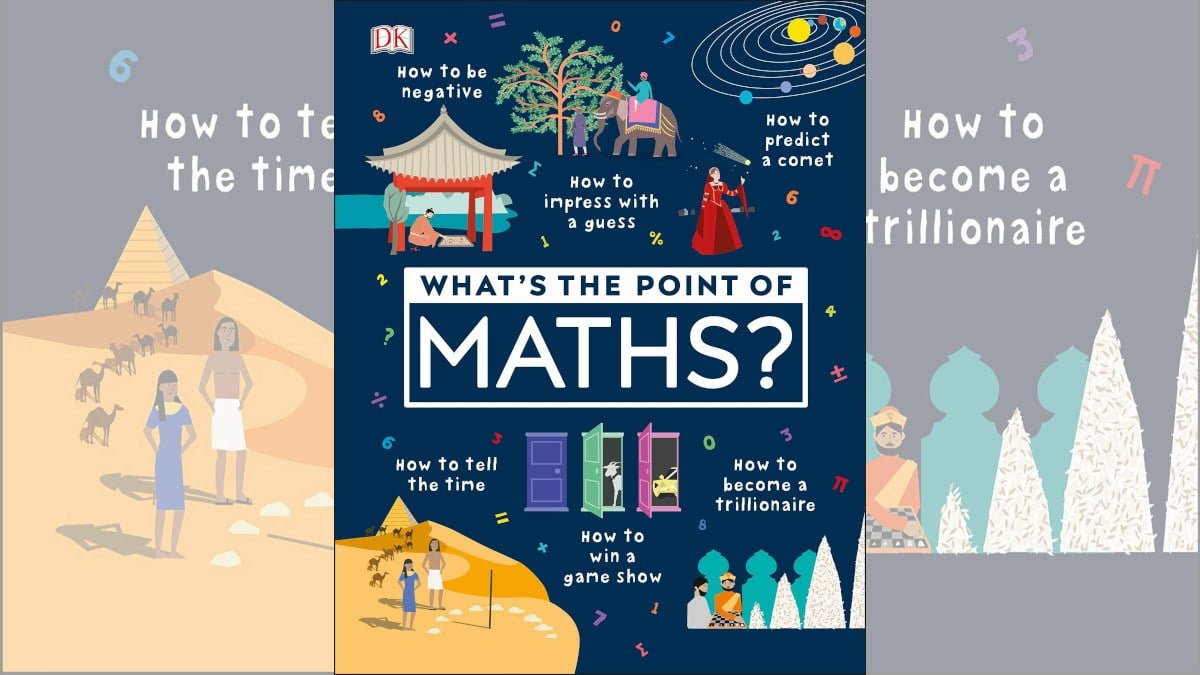This Week’s Word Is “Mathematics.”
My first DK book of 2020 raises the specter of that perennial cross-Atlantic divide: Math v Maths. My copy of this book is called What’s the Point of Maths?, U.S. readers copies will inevitably have dropped the ‘s’. Fortunately, no matter who you spell math(s), the numbers never change. What’s the Point of Math? is a book aimed at 9-11-year-olds, that aims to inspire a love of numbers and all things mathematical.
What Is What’s the Point of Math?
It’s a 125 page, A4 sized hardback devoted to math and the wonder of numbers. It looks at how numbers underpin almost everything we take for granted, even if its influence may not at first be obvious, such as music and art. The book uses colorful illustrations rather than the traditional DK stock-photographs approach, but they definitely help bring the subject to life.
Like many DK books, What’s the Point of Math? is broken down into several color-coded sections. Each of which asks “What’s the Point of…?”
1. Numbers and Counting.
Starting with the earliest calendars, this section explains the importance of counting. It looks at different number systems and how they evolved from counting different body parts. I had no idea that the Babylonian base 60 was created using our hands. From here, the book moves into the evolution of written numbers and the “invention” of zero.
After looking at negative numbers, this section moves onto the invention of percentages (for tax purposes!), fractions, and proportions. There’s a great page on how to work out whether bargains in supermarkets are really as good as they seem. The final double-page in this section briefly introduces algebra.
2. Shapes and Measuring.
Shapes and symmetry are examined in this section: Beehives, squares, cubes, and stars. We then take a deep dive into triangles and measuring areas before moving into trickier questions like how to measure the Earth and what exactly is pi, and why can’t you eat it?
More abstract measurements are examined in a time-measuring timeline (how meta is that?!) and several pages are dedicated to maps and coordinates.
3. Patterns and Sequences.
My favorites section. Comets and Codes, Cyphers and Sequences. I was fascinated by series as a kid, and to a certain extent, I still am, so this section was pure manna. Gauss’s folded numbers and arithmetic sequences are here, such as doubling grains of rice on a chessboard. After that, the section moves onto the importance of prime numbers and infinity. All this reminded me of the maths explained in the excellent Number Devil by Hans Magnus Enzensberger, which is something of a family favorite.
4. Data and Statistics.
Estimating, and how to appear magically good at it. This section looks at mode, mean, and median, before showing how you can use data to make changes for good. It does this using Florence Nightingale’s data gathering about the deaths of soldiers during the Crimean War. The final part of this section is a timeline of the history of computers.
5. Probability and Logic.
The Monty Hall problem – or how to win a game show. My wife refuses to understand the logic behind this idea, but perhaps this book will convince her? After Monty Hall, we have the prisoner’s dilemma.
At the very end of the book is a glossary and a great little timeline of brilliant male and female mathematicians from down the ages. From Hypatia to Emma Haruka Iwao via (among others), Fibonacci, Da Vinci, Emmy Noether, Isaac Newton, Alan Turing, and Katherine Johnson.
Why Read What’s the Point of Math?
This is the perfect book for any child fascinated by numbers who wants to go beyond the nuts and bolts they learn at school. Books that show the importance of math in the real world, with practical applications, are invaluable for inspiring a love of the subject. I’m fortunate to have sons who love math, and they’ve been poring over this book. (One of them is as fascinated by the rice on the chessboard, as I was at a similar age. What is it about doubling things?)
Whilst the book is undoubtedly great for children who already have a love of math, I think it has a place for those who are less interested in the subject too. By taking a host of real-world applications, there are many different entry points for children who aren’t just here for the love math. The book’s layout invites investigation even if you only have a passing interest in the subject.
The explanations in What’s the Point of Math? are clear and concise and its simple diagrams bring further clarity. Like most DK books, this is well-executed, with text broken up into readable chunks and sections and topics gathered together in a sensible fashion that builds on what’s come before.
I would love this book to become a series. This volume, impressive though it is, barely scratches the surface and there is so much more inspiring math and many more mathematicians that many children would love to discover. DK does these types of school-level books so well, (such as The Science Squad) and What’s the Point of Math? is a worthy addition to their catalog.
You can pick up a copy of What’s the Point of Math? here, in the US, and you can add an ‘s’ and buy it here, in the UK.
If you enjoyed this post, do check out my other Word Wednesday reviews.
Disclosure: I received a copy of this book in order to write this review.








